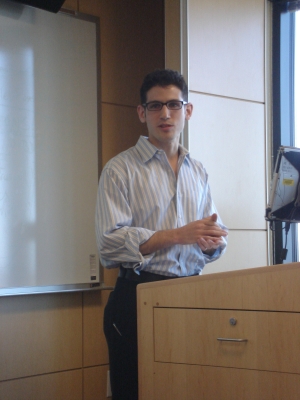Thanks to
Mary for this blog post, which is also posted on
I&D blog.
 glam shot
glam shotNote: This post in the second in a series on a panel, entitled "ICT and Public Diplomacy" at the
Edward R. Murrow 100th Anniversary Conference on public diplomacy at the
Fletcher School of Diplomacy at Tufts University. The first post covered the
presentation of Berkman fellow Ethan Zuckerman.
Joshua Goldstein is a master's candidate at the Fletcher School of Government, with a focus on Africa, and a research assistant for the Internet & Democracy Project. He begins with a plug for the Audio-Visual Club, a group of graduate students who meet at a bar down the street from the Fletcher School to discuss the intersection of public affairs and technology. Josh also mentions how his interest in technology began when he was part of a team using an Internet application to determine issues of land tenure in Uganda.
In December of 2007, the Kenyan elections occurred, pitting the incumbent, Mwai Kibaki against challenger Raila Odinga. When a winner was not immediately announced and Kenya fell into economic instability, technologies were used both by groups interested in promoting messages of hate as well as peace and reconciliation. One of the key groups of activists were Kenya's bloggers.
The Kenyan blogosphere has been active since 2003, one of the most active in Sub-Saharan Africa. There are over 400 blogs in the country although the national Internet penetration is less than 10%. From approximately December 25th to January 1st there was a media black-out in Kenya, making the role of blogs all the more critical to the collection and dissemination of information. Blogs like
AfroMusing,
Mentalacrobatics, and
Mzalendo reported and posted photographs of the aftermath.
One of the most interesting technological outcomes of the crisis was a map mash-up called
Ushahidi (witness) which allowed people on the ground in Kenya to send texts and video taken via cell phone, which appear on an online map of Kenya. This kind of "mash-up," which combine different types of media (video, text, and a map, in this case). Mash-ups are a critical new tool in visualizing data.
However, technology was also used to encourage hate. Text messages like this:
"Fellow Kenyans, the Kikuyu's have stolen our children's future...we must deal with them in a way they understand...violence."
"No more innocent Kikuyu blood will be shed. We will slaughter them right here in the capital city. For justice, compile a list of Luo's you know...we will give you numbers to text this information."
These messages were sent en masses, hoping to stir up ethnic violence. The Kenyan government was considering shutting down mobile phone service in the country to put a hault to these incitations to violence, but Safaricom's CE0, Michael Joseph, convinced them not shut down his network but instead sent text messages of peace and calm to its 9 million subscribers. A chat room called
Mashada, however, was also shut down due to pervasive hate speech between Lou and Kikuyu.
What does this mean to governments interested in public diplomacy? If you want to influence people, get involved in networks. The online space is another public sphere, which can influence and exert influence which touches the outside world (online organizing during the Orange Revolution in Ukraine, which Josh has also
written on, provides another key example.) There are great opportunities for engagement, though doubtless new challenges as well.
Labels: east africa, Internet and Democracy


 Joshua Goldstein is in search of the best route to bicycle from Kampala to Capetown.
Joshua Goldstein is in search of the best route to bicycle from Kampala to Capetown.